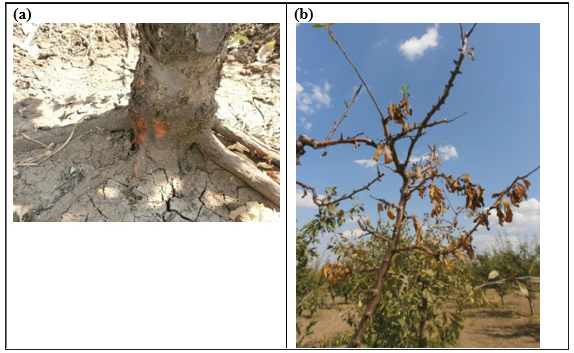- Submissions

Full Text
Modern Concepts & Developments in Agronomy
Phytophthora Root and Crown Rot of Plum
Vagelas IK*
University of Thessaly, Department of Agriculture Crop Production and Rural Environment, Fytokou St., N. Ionia, GR-38446 Magnesia, Greece
*Corresponding author: Vagelas IK, University of Thessaly, Department of Agriculture Crop Production and Rural Environment, Fytokou St., N. Ionia, GR- 38446 Magnesia, Greece
Submission: August 08, 2020Published: January 05, 2021

ISSN 2637-7659Volume7 Issue 5
Abstract
In this study was investigated the Phytophthora spp., effects on plum trees in Skopelos island, Greece. Trees impacted by Phytophthora showed collar rot symptoms (below ground), crown rot and reddishbrown discoloration of the bark and poor growth with sparse, off-color foliage (above ground). Results showed that improve soil drainage techniques and application of fosetyl-Al when new leaves are hardening proved a good strategy to encourage
I. Healthy new root growth,
II. Reduced Phytophthora root and grown rot symptoms and
III. Increase plum fruits production.
Methodology-Results and Discussion
Figure 1: a) Reddish-brown streaks or zones can be seen on the inner bark of infected plum tree. b) Leaves of plum tree affected by Phytophthora.

Phytophthora spp. were isolated from necrotic root and tissues of decline and dead plum trees in 22 plum orchards in Skopelos, Greece. In details, a total of 152 samples of decline and dead plum trees were collected and analysed at Phytopathology Lab of the University of Thessaly, through 2012-13 and 2015-17 [1]. All decline trees attributed the following symptoms, crown and collar rot and reddish-brown discoloration of the bark (Figure 1a). Trees with crown symptoms show a gradual loss of vigor and decline of the top generally have a reduced number and size of leaves produced. The leaf color during the warm weather, late May and middle summer were observed to turn prematurely yellow, wilt, dry, and remain attached to the tree (Figure 1b). Trees with foliar symptoms usually were associated with loss of canopy, showed branch dieback symptoms and eventually ending in death of the stunted growth tree [2]. The most outstanding symptom of the loss of canopy and the real cause for death of the top of the tree is the slowly developing canker on the lower trunk near the ground line, the “crown” region of the tree (Figure 1a). These cankers extended from the crown of the root system to ground level and along the lateral roots. In a lot of cases (especially in 3-5 years old plum trees), the canker girdled the trunk and the bark within the canker was completely rotted and the outer wood discolored. In all cases Phytophthora spp. were isolated from all samples showed that Skopelos local cultivar or certain local rootstocks have no tolerance to Phytophthora root and grown rot disease. Improve soil drainage techniques (drill holes into smooth sections of the trunk or main roots) and application of fosetyl-Al 80% (WG) when new leaves are hardening proved a good strategy
I. To encourage healthy new root growth,
II. Reduced Phytophthora root symptoms and
III. Increase plum fruits production (Figure 2a&2b).
Figure 2: a) Treated plum tree. b) With fosetyl-Al (80%) when new leaves are hardening compared to untreated plum tree.

References
© 2021 Vagelas IK. This is an open access article distributed under the terms of the Creative Commons Attribution License , which permits unrestricted use, distribution, and build upon your work non-commercially.
 a Creative Commons Attribution 4.0 International License. Based on a work at www.crimsonpublishers.com.
Best viewed in
a Creative Commons Attribution 4.0 International License. Based on a work at www.crimsonpublishers.com.
Best viewed in 







.jpg)






























 Editorial Board Registrations
Editorial Board Registrations Submit your Article
Submit your Article Refer a Friend
Refer a Friend Advertise With Us
Advertise With Us
.jpg)






.jpg)














.bmp)
.jpg)
.png)
.jpg)










.jpg)






.png)

.png)



.png)






